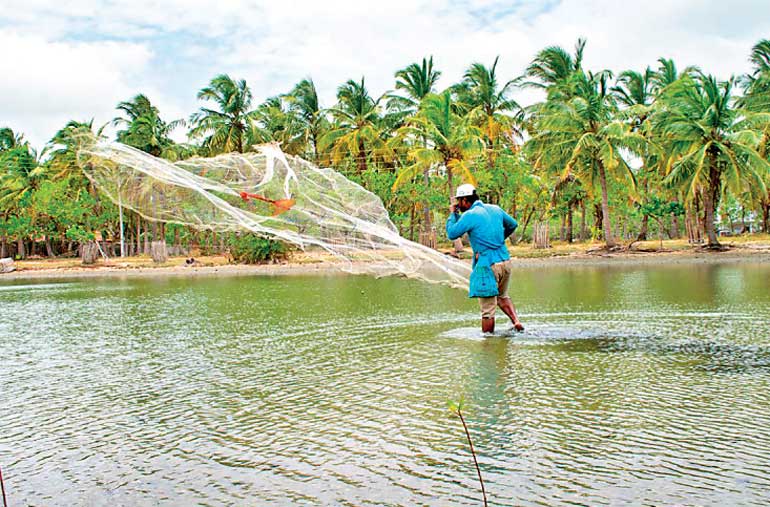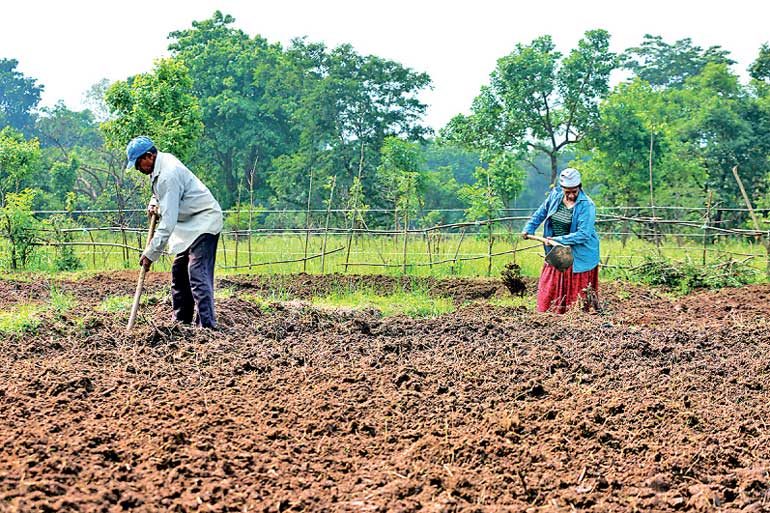Tuesday Apr 22, 2025
Tuesday Apr 22, 2025
Saturday, 11 September 2021 00:05 - - {{hitsCtrl.values.hits}}

Food systems can be made more sustainable by localising supply chains and reducing food miles
 In less than two weeks, the United Nations Food Systems Summit (UNFSS) will take place during the United Nations General Assembly in New York, USA.
In less than two weeks, the United Nations Food Systems Summit (UNFSS) will take place during the United Nations General Assembly in New York, USA.
Leading up to this major event, countries are convening national dialogues to gather issues, challenges, and solutions for their own food systems that will feed into the Summit’s larger discussion. In addition to these national dialogues, organisations around the world are also conducting independent dialogues to add a multitude of perspectives and voices to the process.
In Sri Lanka, the Ministry of Agriculture is leading work on the UNFSS 2021 and just completed a series of national and provincial dialogues to identify the most pressing and important challenges for the country’s food systems. These consultations included relevant Government officials at national and provincial level and other key entities working on agriculture, livestock, fisheries, and related sectors including cross-cutting areas interlinked with food systems. In parallel to the national dialogues, a series of independent dialogues was conducted to capture youth and youth perspectives as well.
Overall, it can be highlighted that Sri Lanka’s food systems are faced with multiple challenges such as climate change affecting weather and growing conditions, disaster events, the COVID-19 pandemic disrupting supply chains, and market-related factors. 80% of total food production in Sri Lanka comes from smallholder farmers which operate with an average farm size of less than two hectares. This leads to difficulties due to land fragmentation, operation of machinery and other equipment, and low financial resources of individual farmers.
To further analyse these challenges and find solutions, the participants of the UNFSS dialogues contributed information related to their provinces, their work, and their area of expertise which revolved around resources, inputs, innovations, awareness, and policies and regulations.
As the UNFSS is structured around five action tracks that cover food security, sustainable consumption, the environment, livelihoods, and resilience to climate change impacts, inputs were collected under these categories. In addition, the global food systems summit process has also identified five “levers of change” that are cutting across all action tracks: gender, human rights, finance, and innovation.
Food security and access to food
The first action track of the UN Food Systems Summit addresses the need for everyone to have reliable and sufficient access to food and nutritional security. This is made harder by gaps in agricultural infrastructure (for example cold-storage facilities), gaps in seed distribution mechanisms and seed quality, lack of appropriate farm machinery and equipment, harvest and post-harvest losses, lack of awareness of food safety and nutritional quality standards, and limited direct access to markets.
The reduction of food waste and post-harvest losses alone could make a huge difference and help food systems to be much more efficient from the source to the table and beyond. Often, it is not necessary to transport food over long distances, and investing in localised supply chains and markets could reduce the need for storage facilities and lessen the mismatch between supply and demand. Another key strategy could include the promotion of locally available nutritious foods or plant-based food options, and the strengthening of home garden and agroforestry cultivation.
Annual cropping calendars could consider agroecological conditions and crop diversification, including area-specific traditional varieties, to ensure year-round sustainable production. Encouraging good post-harvest practices offers another way to contribute to sustainable production and consumption, as does awareness creation on the advantages of consuming undervalued local produce (such as moringa leaves or freshwater fish).
Sustainable consumption and production
UNFSS Action track 2 is about a shift to sustainable consumption patterns, which is something that everyone can contribute to if their basic requirements are met and they have the freedom to make informed choices. Food is one of the most basic human needs, and the nature of its production can make a big difference to the health and wellbeing of humans, the environment, and the planet.
On the production side, there is a need for new financial schemes and other incentives to boost sustainable, nature- and climate-friendly food production. Sri Lanka has bountiful natural resources that can be the basis of many sustainable enterprises, including organic farming, agroforestry, home garden cultivation, aquaculture or mariculture systems, seaweed cultivation, hydroponics, aquaponics, biofloc, or value addition to existing crops and animal products.
For consumers, trusted and well-known certifications, standards, eco-labels, and accreditation schemes could make a big difference and allow informed decision-making. Plastic pollution can be avoided through better packaging and wrapping methods as well as the avoidance of heavily packaged food products, and there are many possible preservation techniques that do not require chemicals, such as smoked fish, lunu dehi, or achcharu.
Another main aspect is the need for additional research on consumption patterns across different provinces and different demographic groups. Such research could identify the reasons for healthy and unhealthy consumption and identify key indicators for food selection, which could be the basis for outreach and awareness creation activities.
Food systems and the environment
Boosting nature-positive production is the focus of the third action track, as food systems can find themselves at odds with the protection of natural ecosystems and biodiversity. Land space is limited, and balancing land use between nature and human needs is an important consideration to avoid deforestation, environmental degradation, and human-wildlife conflict.
How can food producers be conscious of this fact and contribute to a mutually beneficial balance? Key measures include conserving and improving soil fertility in degraded lands, establishing diversified production systems for smallholder farmers (such as integrated crop-livestock-fisheries systems or agroforests), using bio-pesticides and bio-fertilisers, promoting natural weedicides, insecticides, and insect repellents, and adopting regenerative soil and water management practices.
In many cases, it might be possible to adopt technologies and practices that provide renewable energy sources, increase water use efficiency, reduce conveyance losses, improve rainwater harvesting and retention, or waste management. If farmers and other stakeholders are educated on environmental sustainability and aware of different technologies and options, there is a higher chance of them transforming their own practices and contribute to nature-friendly production.
Livelihoods and just transition
Action track 4, advancing equitable livelihoods, is closely linked to the issue of just transition, which means a large-scale transformation of economies and societies that leaves no one behind. There is a number of important elements to this: Institutional arrangements and policies, a social dialogue, skills development and retraining, protection of livelihoods, and social protection. Just transition and food system livelihoods are also closely connected to gender equity and the involvement of women in production, value addition, and other economic activities.
Participants to the dialogues elaborated on the need to strengthen systems for resource distribution, coordination, and monitoring of livelihood development to eliminate poverty, hunger, and vulnerability of affected communities. The importance of enforcing existing rules and regulations in all stages of the supply and value chains and disseminate information on resources distribution and coordination among all stakeholders was also pointed out.
Farmers and other food producers can be helped through financial and technical support, for example through low-interest loans, productive safety nets, and enhanced insurance mechanisms. Developing a public and accessible knowledge portal could provide provincial and local-level information needed to improve agricultural livelihoods and good practices as well as to incentivise stakeholders to enhance transparency and accountability for their activities. Furthermore, skill development institutions could be established near vulnerable areas, connecting trained farmers to profitable markets alongside the training on new livelihood opportunities.
Climate change and food systems
The fifth and last action track aims to render food systems resilient to vulnerabilities, shocks, and stresses, including those caused by climate change. It is well established in science and research that global warming is leading to significant impacts on agriculture, including rising temperatures and heat waves, water scarcity, droughts, floods, storms, soil degradation, more pests and diseases, and sea level rise.
As in all action tracks, it is vital to not only ask how farmers are impacted, but also how they can respond. The start is awareness, but resilience-building does not end there. Addressing hazards and avoiding losses and damages can be facilitated by risk reduction and risk management techniques, for example through long-term planning processes, early warning systems, shock-resistant infrastructure, risk transfer mechanisms, and risk finance.
One possibility discussed was conducting demonstrations at the village level, strengthening links between producers and consumers, and creating model villages for integrated sustainable and climate-resilient food systems.
The special role of youth
In parallel to the national dialogues, a series of independent dialogues was conducted to specifically engage youth and gather their impressions, experiences, and ideas for food systems in Sri Lanka. From these events, key areas and youth-specific findings were compiled and key areas of focus identified to build resilience and sustainability of food systems through enhanced youth engagement.
The participants found that young people are hesitant to engage in agriculture, and many youth from rural areas abandon their traditional family livelihoods in search of employment that promises a steady income and less vulnerability to climate and market risks. Possible solutions to this issue include enhancing the recognition of agricultural livelihoods, giving them a better "branding," and providing incentives for youth to engage, for example through seed funding, certification courses, technical support, on-the-ground training opportunities, safety nets, and career paths for qualified graduates with food-related degrees. Another important aspect named for youth was the increasing prevalence of unhealthy and unsafe food consumption patterns. Participants highlighted that youth are consuming a lot of heavily processed, sugar- and fat-heavy foods that lead to non-communicable diseases, micronutrient deficiencies, and other long-term health issues. To combat this, education and awareness could play a key role, as could the sharing of innovative and timesaving food preparation methods using local ingredients, investment in preservation technology, marketing of seasonally available local fruit drinks, and the fostering of healthy food entrepreneurship.
Other suggestions included direct funding to support youth entrepreneurs, promoting home gardening in urban settings, or offering vocational training courses to build capacities on developing products based on locally available sources without exploiting natural resources. It would also be important to conduct research and identify the key indicators for choosing unhealthy or unsustainable food, and better understand which segments of the population should be targeted by outreach and education.
Amplifying the voices of youth to gives them a space to participate in policy processes and launch their own initiatives, projects, and enterprises that contribute to nature-friendly and climate-resilient food production. Publicity could be given to youth-led production through social media campaigns and showcasing champions, innovations, and good practices.
The Food Systems Summit and beyond
There are many more challenges and solutions that have been identified and present opportunities to take work beyond the Summit, which will provide a way to share successes as well as lessons learned and be part of solutions identified for collective implementation.
Food systems around the world are faced with complex threats, including climate change. Due to inefficiencies and long supply chains, they are often unable to deliver food security to vulnerable populations or ensure an adequate and healthy nutritional supply. Therefore, it is vital for every country, community, and individual to understand the implications and true costs of food production, make informed decisions on what to consume, and contribute to transforming food systems to be more sustainable, ethical, nature-positive, and climate-smart.

Small-scale fisheries are an important sub-sector of Sri Lanka's food systems

There are many options for food systems to be made more sustainable, nature-friendly, and resilient
Pix courtesy SLYCAN Trust
(The writer works as Director – Research & Knowledge Management at SLYCAN Trust, a non-profit think tank based in Sri Lanka. His work focuses on climate change, adaptation, just transition, human mobility, and a range of related issues. He holds a Master’s degree in Education from the University of Cologne, Germany and is a regular writer to several international and local media outlets.)
Discover Kapruka, the leading online shopping platform in Sri Lanka, where you can conveniently send Gifts and Flowers to your loved ones for any event including Valentine ’s Day. Explore a wide range of popular Shopping Categories on Kapruka, including Toys, Groceries, Electronics, Birthday Cakes, Fruits, Chocolates, Flower Bouquets, Clothing, Watches, Lingerie, Gift Sets and Jewellery. Also if you’re interested in selling with Kapruka, Partner Central by Kapruka is the best solution to start with. Moreover, through Kapruka Global Shop, you can also enjoy the convenience of purchasing products from renowned platforms like Amazon and eBay and have them delivered to Sri Lanka.
Discover Kapruka, the leading online shopping platform in Sri Lanka, where you can conveniently send Gifts and Flowers to your loved ones for any event including Valentine ’s Day. Explore a wide range of popular Shopping Categories on Kapruka, including Toys, Groceries, Electronics, Birthday Cakes, Fruits, Chocolates, Flower Bouquets, Clothing, Watches, Lingerie, Gift Sets and Jewellery. Also if you’re interested in selling with Kapruka, Partner Central by Kapruka is the best solution to start with. Moreover, through Kapruka Global Shop, you can also enjoy the convenience of purchasing products from renowned platforms like Amazon and eBay and have them delivered to Sri Lanka.